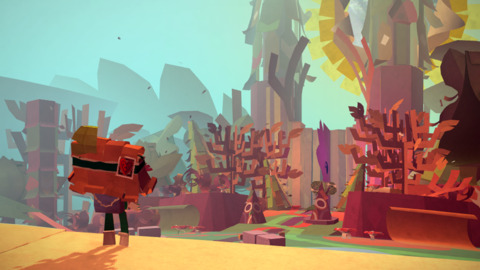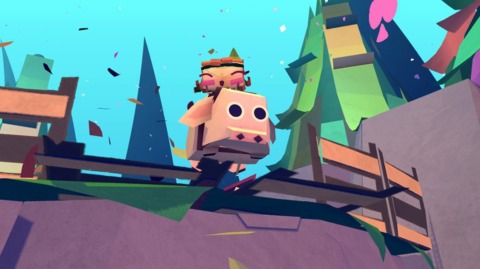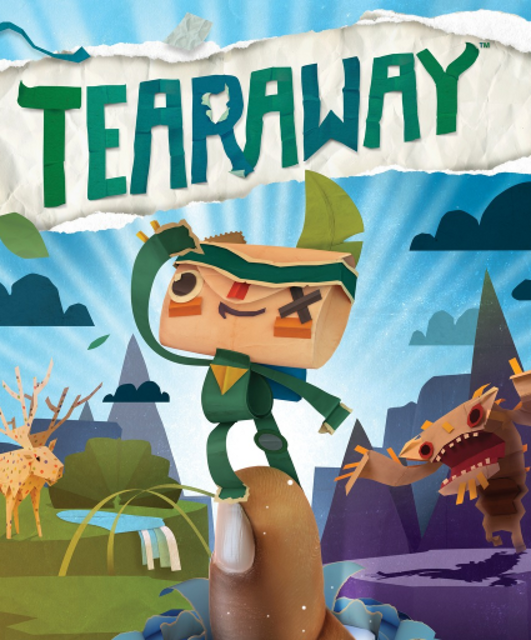I've been taking a video games and literature course over the past few months, which has forced me to look at important themes and messages in games, even when they may appear nonexistent. Such is the case with Tearaway, which I finished over the weekend and enjoyed immensely. While playing I was struck by the way the narrative handles surprisingly complex topics, which then compelled me to write about it. I kind of wrote this for myself as a simple practice exercise, but I figure I might as well share my thoughts here. Feel free to let me know if I'm on to something, or if this reads like the incoherent ramblings of a random internet dude.
SPOILER WARNING: There are some light story spoilers in here, and I do address the ending without actually... spoiling the ending. In any event, read with caution if you have yet to play the game.
The Metanarrative of Tearaway
In many ways, Tearaway is a game about superficial artifice. Its distinctive arts-and-crafts visuals evoke an all-ages warmth that extends to the lighthearted humor and storybook narrative, while the game's status as a portable release provides casual immediacy in the face of big-name console titles. But an extensive focus on these superficial characteristics potentially disregards the larger themes and ideas explored in Tearaway – namely its careful consideration of the player/creator dynamic and how it affects narrative, and the link between virtual and physical worlds.
Tearaway presents players with a simple narrative foundation and then proceeds to turn it on its head. Messengers iota/atoi (appropriately shaped as envelopes in the game), are tasked with delivering a message to an important figure. It's a narrative frame we've encountered numerous times across multiple mediums – the long journey to deliver an important item or message – but developer Media Molecule twists the formula by making that important figure "You."

Our ideas of the conventional plot would label iota/atoi as the protagonist, but "You" are the central character in Tearaway. Just look at the emphasis on names – iota/atoi are not capitalized, as if they were simply words in a dictionary. But "You" are special; the capitalized 'Y' looms over everyone else in the narrative. In addition, the inhabitants of the magical paper world distinctly address "You" as the key source of turmoil. The player's mysterious appearance brings forth evil Scraps, enemies that pose a danger to everyone, and the characters are constantly reminded of that by the luminous face of the player in the sun (courtesy of the PlayStation Vita's integrated camera).
If the source of evil in Tearaway comes from the player, that makes "You" the villain. But not everyone in the game's world shares this vision – many refer to "You" as a god meant to help iota/atoi on their important journey. This parallels the very nature of the player's relationship with the creator of the video game – in some ways we may pose a threat to the developer's artistic vision. Perhaps I choose to ignore important narrative themes and game mechanics, and thus devalue the overall product. But at the same time, the player remains absolutely vital. A video game cannot be a "game" if no one is there to play it. Media Molecule recognizes the player as essential despite the potential threat, just as the characters of Tearaway recognize the power of "You" in the face of immediate danger.
Tearaway also explores the player/creator relationship as it relates to authorship. Media Molecule signifies this dilemma with the use of two narrators in the game. The male narrator helps guide iota/atoi on their journey, and that journey appears to be at an end until the female narrator interferes and creates new obstacles for iota/atoi and the player. This interference speaks to a need for narrative innovation, but the female narrator does not succeed in her attempt to change the foundation. We still come across familiar settings and challenges; only at the end do we see some kind of meaningful change, as both narrators begin to embrace the communal aspect of storytelling.

Media Molecule crafts Tearaway as a linear journey, but the game's last few worlds begin to explore creatively adventurous possibilities. In fact, the worlds are presented as figurative canvases, in which the narrators urge the player to create their own internal narrative. The responsibility of storytelling gradually begins to shift from Media Molecule to “You.” This shift only begins with the conclusion of the game's narrative – it continues in the physical realm.
Throughout the game, players can take pictures of white objects in order to give them color, which then adds to a papercraft collection. They can then use the Tearaway community website in order to access the papercrafts and construct them in real life. The physical papercrafts are not part of the virtual experience Tearaway offers, but they do encompass the ability of video games to link physical and virtual worlds in meaningful ways.
The basic narrative in Tearaway ends when the video game ends... but what if I create iota/atoi papercrafts in real life? And create an entire paper world with cute creatures and beautiful landscapes? This speaks to that shift of authoritative responsibility, in which Media Molecule gives players the tools to continue the narrative or create entirely new ones. Just as the developer welcomes us into their world, we can now welcome them into worlds of our own. Thus, a unique feeling of community enters the foundation of storytelling and provides the much-needed innovation.

Log in to comment